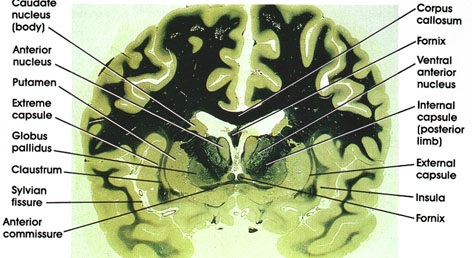

Plate 17.344 Diencephalon
Ronald A. Bergman, Ph.D., Adel K. Afifi, M.D., Paul M. Heidger,
Jr., Ph.D.
Peer Review Status: Externally Peer Reviewed

Human, 10% formalin, Weigert's hematoxylin (Loyez), 0.9 x.
Corpus callosum: A massive bundle of myelinated fibers connecting the two hemispheres. Important in interhemispheric transfer of information.
Fornix: C-shaped, paired fiber system connecting the hippocampus with several brain regions, including the mamillary body, anterior thalamic nucleus, septal nuclei, and cingulate gyrus. Seen in two locations in this figure, beneath the corpus callosurn and above the anterior commissure.
Ventral anterior (thalamic) nucleus: One of the lateral group of thalamic nuclei. Characteristically traversed by heavily myelinated fiber bundles. Receives fibers from the basal ganglia and is reciprocally connected with the cerebral cortex. Plays a role in motor control.
Internal capsule (posterior limb): Separates the thalamus from the basal ganglia (putamen and globus pallidus). Carries fibers from and to the cerebral cortex. Lesions result in contralateral motor and sensory deficits.
External capsule: An efferent cortical bundle sandwiched between the putamen and claustrum.
Insula: Also referred to as the island of Reil,* lies deep in the sylvian fissure. Concerned primarily with autonomic function.
Caudate nucleus (body): A component of the basal ganglia. The body of the caudate is continuous rostrally with the head of the caudate and caudally with its tail. Plays a role in motor control.
Anterior (thalamic) nucleus: Belongs to the anterior group of thalamic nuclei. Has reciprocal connections with the mamillary body via the mamillothalamic tract and with the cingulate gyrus via the internal capsule. Considered part of the limbic system and thus plays a role in emotional behavior and memory.
Putamen: One of the basal ganglia nuclei. Concerned with motor control.
Extreme capsule: An efferent cortical bundle. Situated between the claustrum and the insula.
Globus pallidus: One of the basal ganglia nuclei. Located medial to putamen and characteristically traversed by heavily myelinated fiber bundles. Receives fibers from the caudate and putamen and projects to the thalamus (ventral anterior nucleus). Has also reciprocal connections with the subthalamic nucleus.
Claustrum: A thin layer of gray substance located between the external and extreme capsules.
Sylvian fissure: A major fissure on the lateral surface of the hemisphere separating the temporal from the frontal and parietal lobes.
Anterior commissure: A compact fiber bundle in close proximity to the fornix. Interconnects the olfactory bulbs and the temporal cortices.
*Reil was an eighteenth -century German physician, neurologist, and histologist.
Next Page | Previous Page | Section Top | Title Page
Please send us comments by filling out our Comment Form.
All contents copyright © 1995-2025 the Author(s) and Michael P. D'Alessandro, M.D. All rights reserved.
"Anatomy Atlases", the Anatomy Atlases logo, and "A digital library of anatomy information" are all Trademarks of Michael P. D'Alessandro, M.D.
Anatomy Atlases is funded in whole by Michael P. D'Alessandro, M.D. Advertising is not accepted.
Your personal information remains confidential and is not sold, leased, or given to any third party be they reliable or not.
The information contained in Anatomy Atlases is not a substitute for the medical care and advice of your physician. There may be variations in treatment that your physician may recommend based on individual facts and circumstances.
URL: http://www.anatomyatlases.org/